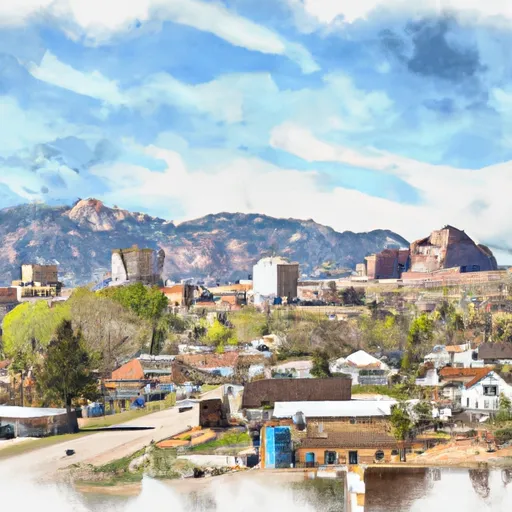-
 Snoflo Premium
Snoflo Premium
Get unlimited access to all our content
With no Ad interruptions! - Start Your Free Trial Login with existing account
Silt
Eden Index
Climate
8.5
•
Recreation
6.6
•
Community
0.8
•
Safeguard
5.9/10

Silt, Colorado is a small town located in Garfield County with a population of around 3,000 residents. The town enjoys a semi-arid climate, characterized by hot summers and cold winters. Summers in Silt are often dry and warm, with temperatures averaging in the mid to high 80s°F (30s°C). Winters can be cold, with temperatures dropping to the mid-20s°F (-4°C).
Hydrology in Silt is primarily influenced by the Colorado River, which flows nearby. The river provides essential water resources for agriculture and various recreational activities. Silt also benefits from several streams and creeks that contribute to the local hydrological system.
When it comes to outdoor recreation, Silt offers numerous opportunities. The nearby Flat Tops Wilderness Area provides an ideal spot for hiking, camping, fishing, and hunting, with its scenic trails and diverse wildlife. The nearby Colorado River offers excellent opportunities for rafting and kayaking. Additionally, the surrounding mountains provide ample opportunities for skiing, snowboarding, and snowshoeing during the winter months.
In summary, Silt, Colorado offers a semi-arid climate with hot summers and cold winters. With its proximity to the Colorado River and surrounding mountains, residents and visitors can enjoy a range of outdoor activities, including hiking, camping, fishing, rafting, and skiing.
What is the Eden Index?
The Snoflo Eden Index serves as a comprehensive rating system for regions, evaluating their desirability through a holistic assessment of climate health, outdoor recreation opportunities, and natural disaster risk, acknowledging the profound impact of these factors on livability and well-being.
Climate Health Indicator (CHI): 8.5
Silt receives approximately
340mm of rain per year,
with humidity levels near 58%
and air temperatures averaging around
9°C.
Silt has a plant hardyness factor of
6, meaning
plants and agriculture in this region thrive during a short period during spring and early summer. Most
plants will die off during the colder winter months.
By considering the ideal temperature range, reliable water supplies, clean air, and stable seasonal rain or snowpacks, the Climate Health Indicator (CHI) underscores the significance of a healthy climate as the foundation for quality living.
A healthy climate is paramount for ensuring a high quality of life and livability in a region, fostering both physical well-being and environmental harmony. This can be characterized by ideal temperatures, reliable access to water supplies, clean air, and consistent seasonal rain or snowpacks.
Weather Forecast
Streamflow Conditions
Colorado Headwaters
Area Rivers
Colorado Headwaters
Snowpack Depths
Colorado Headwaters
Reservoir Storage Capacity
Colorado Headwaters
Groundwater Levels
Recreational Opportunity Index (ROI): 6.6
The Recreational Opportunity Index (ROI) recognizes the value of outdoor recreational options, such as parks, hiking trails, camping sites, and fishing spots, while acknowledging that climate plays a pivotal role in ensuring the comfort and consistency of these experiences.
Access to outdoor recreational opportunities, encompassing activities such as parks, hiking, camping, and fishing, is crucial for overall well-being, and the climate plays a pivotal role in enabling and enhancing these experiences, ensuring that individuals can engage in nature-based activities comfortably and consistently.
Camping Areas
| Campground | Campsites | Reservations | Toilets | Showers | Elevation |
|---|---|---|---|---|---|
| Aspen Grove - Vega State Park | 27 | 7,999 ft | |||
| Rifle Gap State Park | 146 | 5,969 ft | |||
| Early Settlers - Vega State Park | 33 | 8,008 ft | |||
| Oak Point - Vega State Park | 39 | 8,011 ft | |||
| Pioneer - Vega State Park | 10 | 8,090 ft | |||
| Twin Lake | 13 | 10,395 ft | |||
| Rifle Falls State Park | 18 | 6,527 ft | |||
| Big Creek | 26 | 10,139 ft | |||
| Three Forks | 4 | 7,599 ft | |||
| Weir and Johnson | 12 | 10,483 ft |
Nearby Ski Areas
Catastrophe Safeguard Index (CSI):
The Catastrophe Safeguard Index (CSI) recognizes that natural disaster risk, encompassing floods, fires, hurricanes, and tornadoes, can drastically affect safety and the overall appeal of an area.
The level of natural disaster risk in a region significantly affects safety and the overall livability, with climate change amplifying these risks by potentially increasing the frequency and intensity of events like floods, fires, hurricanes, and tornadoes, thereby posing substantial challenges to community resilience and well-being.
Community Resilience Indicator (CRI): 0.8
The Community Resilience Indicator (CRI) recognizes that education, healthcare, and socioeconomics are crucial to the well-being of a region. The CRI acknowledges the profound impact of these elements on residents' overall quality of life. By evaluating educational resources, healthcare accessibility, and economic inclusivity, the index captures the essential aspects that contribute to a thriving community, fostering resident satisfaction, equity, and social cohesion.

